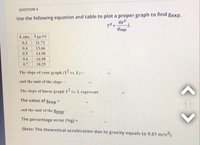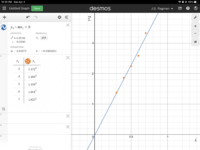I presume some context you omitted might explain the subscript. Is 10 the length of the pendulum, perhaps?
If you plot T^2 against L, you should see that it is not exactly linear, but close. A good idea would be to use the first and last points to get a better sense of the overall slope; any answer is really only an approximation anyway. (They really should tell you that; but it goes without saying if you are learning about real data as opposed to fake math data.) The proper way is to use linear regression, which perhaps you haven't learned and therefore are not expected to do.
Thanks a lot Dr.Peterson for the reply.
If I follow your way to find the slope by taking the first and last points, I get this
[MATH]m = \frac{18.25 - 11.72}{0.7 - 0.3} = 16.325[/MATH]
or I should square the [MATH]T[/MATH] like this?
[MATH]m = \frac{{18.25}^2 - {11.72}^2}{0.7 - 0.3} = 489.26025[/MATH]
I have a linear regression in my calculator
[MATH]y = A + Bx[/MATH]
if i don't use square for the [MATH]T[/MATH], I get
[MATH]A = 7.198[/MATH][MATH]B = 15.48[/MATH] (slope)
So, [MATH]15.48 = \frac{4{\pi}^2}{g_{exp}}[/MATH]
[MATH]g_{exp} = \frac{4{\pi}^2}{15.48} = 2.55[/MATH]
if i use square for the [MATH]T[/MATH], I get
[MATH]A = -3.69284[/MATH][MATH]B = 463.379[/MATH] (slope)
So, [MATH]463.379 = \frac{4{\pi}^2}{g_{exp}}[/MATH]
[MATH]g_{exp} = \frac{4{\pi}^2}{463.379} = 0.085[/MATH] (I feel that this gravitational accelearation does not make sense)
Which method above was correct to approximate the slope?
Is the unit of the slope [MATH]s^2/m[/MATH]?
Is the percentage error, [MATH](1 - \frac{2.55}{9.81}) \cdot \ 100[/math]% [math] = 74[/math]% (too high) why?
[MATH]T_{10}[/MATH] is notation for 10 oscillations (periods) of the pendulum.
Dividing the [MATH]T_{10}[/MATH] values by 10 gives a good average measurement value for a aingle period, [MATH]T[/MATH].
Construct a scatterplot of [MATH]T^2[/MATH] as a function of [MATH]L[/MATH] and perform a linear regression. Most graphing calculators will do this, as will spreadsheets.
Thanks a lot skeeter for the reply.
Do you mean I have to do this to find a good average value for a single period?
[MATH]T_{av} = \frac{11.72 + 13.66 + 14.98 + 16.08 + 18.25}{10} = 7.469 \ s[/MATH]
[MATH]y = A + Bx[/MATH]
Is [MATH]T_{av} = A[/MATH] in this linear equation?
What should I do with this period to proceed next?
I have performed a linear regression by using my calculator. You can see the result above when I was showing Dr.Peterson my results. Can you see them and tell me if there is something wrong?


